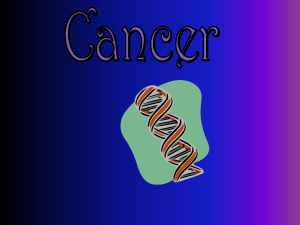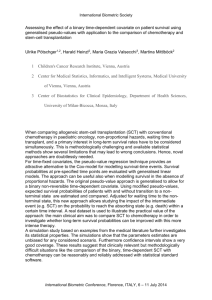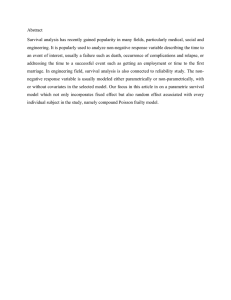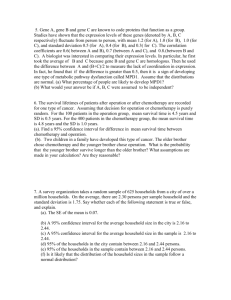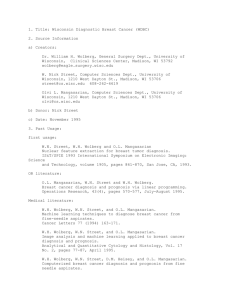Breast Cancer Survival and Chemotherapy: A Support Vector
advertisement
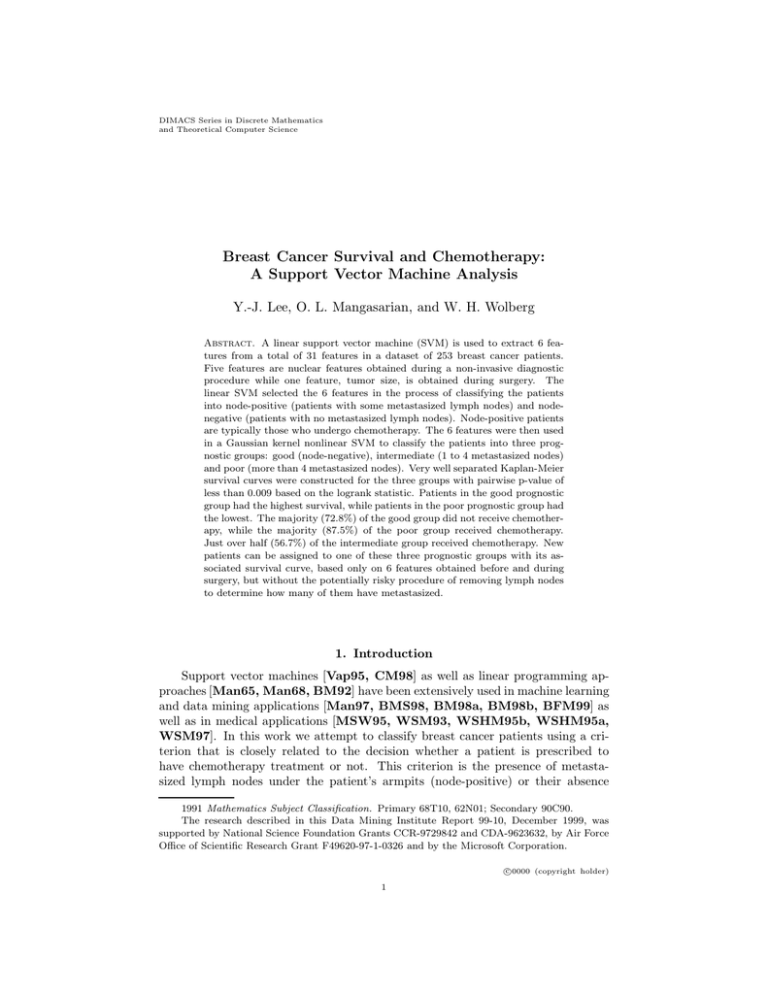
DIMACS Series in Discrete Mathematics
and Theoretical Computer Science
Breast Cancer Survival and Chemotherapy:
A Support Vector Machine Analysis
Y.-J. Lee, O. L. Mangasarian, and W. H. Wolberg
Abstract. A linear support vector machine (SVM) is used to extract 6 features from a total of 31 features in a dataset of 253 breast cancer patients.
Five features are nuclear features obtained during a non-invasive diagnostic
procedure while one feature, tumor size, is obtained during surgery. The
linear SVM selected the 6 features in the process of classifying the patients
into node-positive (patients with some metastasized lymph nodes) and nodenegative (patients with no metastasized lymph nodes). Node-positive patients
are typically those who undergo chemotherapy. The 6 features were then used
in a Gaussian kernel nonlinear SVM to classify the patients into three prognostic groups: good (node-negative), intermediate (1 to 4 metastasized nodes)
and poor (more than 4 metastasized nodes). Very well separated Kaplan-Meier
survival curves were constructed for the three groups with pairwise p-value of
less than 0.009 based on the logrank statistic. Patients in the good prognostic
group had the highest survival, while patients in the poor prognostic group had
the lowest. The majority (72.8%) of the good group did not receive chemotherapy, while the majority (87.5%) of the poor group received chemotherapy.
Just over half (56.7%) of the intermediate group received chemotherapy. New
patients can be assigned to one of these three prognostic groups with its associated survival curve, based only on 6 features obtained before and during
surgery, but without the potentially risky procedure of removing lymph nodes
to determine how many of them have metastasized.
1. Introduction
Support vector machines [Vap95, CM98] as well as linear programming approaches [Man65, Man68, BM92] have been extensively used in machine learning
and data mining applications [Man97, BMS98, BM98a, BM98b, BFM99] as
well as in medical applications [MSW95, WSM93, WSHM95b, WSHM95a,
WSM97]. In this work we attempt to classify breast cancer patients using a criterion that is closely related to the decision whether a patient is prescribed to
have chemotherapy treatment or not. This criterion is the presence of metastasized lymph nodes under the patient’s armpits (node-positive) or their absence
1991 Mathematics Subject Classification. Primary 68T10, 62N01; Secondary 90C90.
The research described in this Data Mining Institute Report 99-10, December 1999, was
supported by National Science Foundation Grants CCR-9729842 and CDA-9623632, by Air Force
Office of Scientific Research Grant F49620-97-1-0326 and by the Microsoft Corporation.
c
0000
(copyright holder)
1
2
Y.-J. LEE, O. L. MANGASARIAN, AND W. H. WOLBERG
(node-negative). Lymph nodes are removed during surgery in conjunction with
the removal of the malignant tumor from the breast. This potentially risky procedure which can cause arm swelling and increased susceptibility to infection can
possibly be eliminated by using the classification procedures proposed here. By
using a linear support vector machine we first select 6 out of 31 available features
to classify patients into node-positive and node-negative patients. We then use
these six features in a nonlinear support vector machine to classify 253 breast cancer patients into three prognosis groups: a good prognosis group (GPG) which is
node-negative, an intermediate prognosis group (IPG) which has 1-4 metastasized
lymph nodes, and a poor prognosis group (PPG) which has more than 4 metastasized lymph nodes. It turns out that these three groups have well separated
survival curves [KM58, Kle96] with very small inter-curve p-values (Figure 3). In
addition, 72.8% of the patients in GPG did not take chemotherapy, while 87.5%
of the patients in PPG took chemotherapy. Only 56.7% of patients in IPG took
chemotherapy. Thus our classification procedure can be utilized to assign new patients to one of three prognostic groups with an associated survival curve and a
possible indication of the utilization of chemotherapy or not.
The paper is organized as follows. Section 2 gives a basic description of the essentials of support vector machines. Section 3 applies the ideas described in Section
2 to the problem of classifying patients using lymph node status as a classification
criterion. Section 4 gives some brief conclusions.
A word about our notation now. All vectors will be column vectors unless
transposed to a row vector by a prime superscript ′ . The scalar (inner) product of
two vectors x and y in the n-dimensional real space Rn will be denoted by x′ y. For
a general norm k · k on Rn , the dual norm k · k′ on Rn is defined as
kxk′ := max x′ y.
(1.1)
kyk=1
For p, q ∈ [1, ∞], p1 + q1 = 1, the p-norm k·kp and q-norm k·kq are dual norms. Thus
the 1-norm k · k1 and ∞-norm k · k∞ are dual norms while the 2-norm is self-dual.
For an ℓ × n matrix A, Ai will denote the ith row of A. The identity matrix in a
real space of arbitrary dimension will be denoted by I, while a column vector of
ones of arbitrary dimension will be denoted by e. We shall employ the MATLAB
“dot” notation [MAT92] to signify application of a function to all components of
a matrix or a vector. For example if A ∈ Rℓ×n , then A2• ∈ Rℓ×n will denote the
matrix obtained by squaring each element of A.
2. Support Vector Machines
We begin with the simple linear support vector machine formulation as follows:
min
(2.1)
w,γ,y
νe′ y + kwk
s.t. D(Aw − eγ) + y
y
≥ e
≥ 0.
Here, ν is a positive weight, k · k is an arbitrary norm and the m × n matrix
A represents m given points in Rn which belong to class 1 or -1 depending on
whether the corresponding elements of the given m × m diagonal matrix D are 1 or
|γ|
-1 respectively. The plane in Rn , with normal w and distance from the origin kwk
BREAST CANCER SURVIVAL AND CHEMOTHERAPY:A SUPPORT VECTOR MACHINE ANALYSIS
3
w
x
x
x
x
x
x x x
A- x x x
x x
x x x
x x
x
x
x
x
A+
x
x x
x
Margin
2
kwk
x′ w = γ − 1
x′ w = γ + 1
Figure 1. A separating plane x′ w = γ, midway and parallel the
bounding parallel planes x′ w = γ ± 1 with maximal separation
2
, is obtained by solving the mathematical program
margin kwk
(2.1).
from the origin, generated by a solution (w, γ) of the above mathematical program:
x′ w = γ,
(2.2)
strictly separates the set A+ := {Ai | Dii = 1} from A− := {Ai | Dii = −1}, if
and only if the slack variable y ∈ Rm is zero as shown in Figure 1. The margin or
distance (measured by a norm k · k′ that is dual to the norm k · k of (2.1)) between
2
[Man99]. These two planes
the bounding planes x′ w = γ ± 1 is given by kwk
′
are parallel to the plane x w = γ and bound the sets A+ and A−. For ν ≥ ν̄
for some ν̄ > 0 [MM79, Theorem 4], the margin is maximized by a solution of
(2.1) that suppresses the slack variable y first. When the sets A+ and A− are
not strictly linearly separable, some components yi of the slack variable y will be
positive. The points Ai in either A+ or A− corresponding to positive yi , as well as
those corresponding to zero yi but with positive Lagrange multipliers, are termed
support vectors. Points Ai with positive yi lie on the wrong sides of the bounding
planes x′ w = γ ± 1, while points with positive multipliers and zero slacks yi lie on
the bounding planes.
We shall employ the 1-norm in the SVM formulation which leads to the following linear programming formulation which has been shown [BM98a] to have one
of the best feature selection properties among all norms including the conventional
2-norm-squared formulation [Vap95, CM98]:
νe′ y + e′ s
min
w,γ,s,y
(2.3)
s.t.
−s ≤
D(Aw − eγ) + y
w
y
≥
≤
≥
e
s
0.
This linear programming formulation will be our SVM1 formulation that will be
used for feature selection in the next section of the paper.
4
Y.-J. LEE, O. L. MANGASARIAN, AND W. H. WOLBERG
In order to obtain a nonlinear support vector machine with a nonlinear separating surface, we make use of the following transformation based on the dual
formulation for the 2-norm-squared support vector machine [Man00]:
w = A′ Du
(2.4)
Substitution in (2.1) gives:
min
u,γ,y
(2.5)
νe′ y + kA′ Duk
s.t. D(AA′ Du − eγ) + y
y
≥ e
≥ 0.
Replacing AA′ by a nonlinear kernel K(A, A′ ) : Rm×n × Rn×m −→ Rm×m , and
kA′ Duk by a convex function of u, typically a norm, results in the following nonlinear generalized support vector machine (GSVM) [Man00]:
min
(2.6)
u,γ,y
νe′ y + kukp
s.t. D(K(A, A′ )Du − eγ) + y
y
≥ e
≥ 0,
with the following nonlinear separating surface instead of a plane:
K(x′ , A′ )Du = γ.
(2.7)
Typical kernel functions are the following:
• Polynomial Kernel (AA′ + µaa′ )d• ,
where [·]d• denotes component-wise exponentiation as in MATLAB [MAT92].
2
• Radial Basis (Gaussian) Kernel ε−µkAi −Aj k , i, j = 1, . . . , m.
′
′
• Neural Network Kernel (AA + µaa )• ∗ ,
where [·]•∗ denotes the step function: R −→ {0, 1} component-wise.
Using the 1-norm in (2.6) leads to a linear programming formulation of the
nonlinear GSVM that we will be using in this work:
νe′ y + e′ s
min
u,γ,s,y
(2.8)
s.t.
−s ≤
D(K(A, A′ )Du − eγ) + y
u
y
≥
≤
≥
e
s
0.
This nonlinear GSVM, which is capable of discriminating between elements of fairly
complex sets, such as the black and white squares of a checkerboard [MM99,
LM99], will be used in the next section. We note that even though the nonlinear
GSVM (2.8) is capable of achieving fairly complex separation, it is not suited for
feature selection, because the kernel K(A, A′ ) creates interactions between all the
features through the variable u which is not present in SVM1 (2.3). That is the
reason we used the linear SVM1 for feature selection and the nonlinear GSVM for
the final separation.
3. Breast Cancer Prognosis and Chemotherapy
In this section of the paper we shall use the support vector machines described
in the previous section to discriminate between 253 breast cancer patients. The
dataset for these patients is publicly available [WLM99]. Our criterion for discrimination will be the absence or presence of metastasized lymph nodes (1 to 30
nodes) removed from the patient’s armpit during surgery. Lymph node metastasis
BREAST CANCER SURVIVAL AND CHEMOTHERAPY:A SUPPORT VECTOR MACHINE ANALYSIS
5
is a strong indicator for chemotherapy. The total number of features used to constitute the n-dimensional space in which the separation is accomplished is made
up of the mean, standard deviation, and maximum (worst) value of ten cytological
nuclear measurements of size, shape and texture taken from the patients breast by
a non-surgical fine needle aspirate procedure [Str94, MSW95] together with the
tumor size excised from the patient’s breast during surgery. Taken together these
constitute the 31-dimensional feature space over which classification according to
lymph node metastasis will be achieved.
Before proceeding with our classification process we exhibit Kaplan-Meier survival curves [Kle96] for 140 of the 253 patients who had chemotherapy and for the
remaining 113 patients that did not have chemotherapy in Figure 2. The solid curve
gives the percent of surviving patients as a function of time for the group that received chemotherapy, while the dashed curve gives the corresponding survival curve
for the group that did not receive chemotherapy. One possible interpretation of this
curve is that the patients not receiving chemotherapy and who have a better survival curve than those who are receiving chemotherapy, are not being compromised
by not receiving chemotherapy. Another interpretation is that most patients who
had chemotherapy were preselected for having lymph node metastasis and hence
had inherently worse cancers. The p-value based on the logrank statistic [Kle96]
relating these two curves is 0.0018. Hence these two curves are statistically distinct. (The logrank statistic is a comparative measure of the survival times of two
groups which calculates a weighted sum of the difference, at each time interval, of
m1
, and the population ratio between
the mortality ratio between the two groups: m
2
n1
the two groups: n2 . Here, mi is the number of deaths in group i and ni is the number of people in group i. The logrank statistic for two groups has a Chi-squared
distribution with degree of freedom one [Kle96]. Larger logrank statistic indicates
significantly different survival curves. That corresponds to a small p-value. The
p-value is the probability that the two survival curves are statistically the same.)
Our next result is the classification of the 253 patients into three prognostic
groups as follows:
1. Good Prognosis “Node-negative patients”: Patients with no metastasized
lymph nodes.
2. Intermediate Prognosis “Node-positive patients” with 1 to 4 metastasized lymph nodes.
3. Poor Prognosis “Node-positive patients” with more than 4 metastasized
lymph nodes.
To achieve this classification we first used SVM1 (2.3) to separate node-negative
patients from node-positive patients. By using a sufficiently small value of ν in (2.3),
ν = 0.02, the SVM1 formulation (2.3) suppressed 25 of the 31 features and selected
a total of 6 features as follows:
1. Mean Area
2. Standard Deviation of Area
3. Worst Area
4. Worst Texture
5. Worst Perimeter
6. Tumor Size (from surgery)
Note that the first five are cytological features obtained from the fine needle aspirate
taken during diagnosis.
6
Y.-J. LEE, O. L. MANGASARIAN, AND W. H. WOLBERG
Kaplan Meier survival curves: Overall (No Chemo. vs. Chemo.)
1
0.9
Breast cancer−specific survival
0.8
0.7
0.6
0.5
0.4
0.3
0.2
0.1
No Chemo: 113 Patients
Chemo: 140 Patients
0
0
20
40
p−value: 0.0018
60
80
100
Time to breast cancer death (months)
120
140
160
Figure 2. Kaplan-Meier survival curve (solid line) for 140 of the
253 patients who received chemotherapy and the corresponding
survival curve (dashed line) for the remaining 113 patients that
did not receive chemotherapy. p-value=0.0018.
We next used the nonlinear support vector machine GSVM (2.8) with a Gaussian kernel with ν = 0.096 to achieve our three-class separation as follows:
1. GPG: Good prognosis group (0 lymph node metastasis)
was separated from all the rest for which:
2. IPG: Intermediate prognosis group (1-4 lymph node metastasis)
was separated from:
PPG: Poor prognosis group (lymph node metastasis > 4).
Note that the separation in Step 2 above included some node-negative patients in
IPG because the separation of Step 1 is not perfect and GPG does not include all
node-negative patients. Tenfold cross validation correctness [Sto74] for the above
separation was 72.8%.
Based on the above separation we constructed three Kaplan-Meier survival
curves for each of the three prognostic groups: GPG, IPG and PPG as shown
in Figure 3. Note that the three curves are very well separated and the p-values
between the three groups are as follows:
1. GPG-IPG p-value=0.0090
2. GPG-PPG p-value=9.5769e-06
3. IPG-PPG p-value=0.0037
These p-values are substantially smaller than the conventional 0.05 cutoff used to
reject the null-hypothesis (survival curves are the same). Hence these curves are
indeed statistically significantly different from each other.
It is worth noting within each of the three prognosis groups how many patients
received and did not receive chemotherapy:
1. GPG: 19 patients received chemotherapy; 51 did not (27.2%;72.8%)
2. IPG: 72 patients received chemotherapy; 55 did not (56.7%;43.3%)
BREAST CANCER SURVIVAL AND CHEMOTHERAPY:A SUPPORT VECTOR MACHINE ANALYSIS
7
Kaplan Meier survival curves: GPG, IPG and PPG
1
GPG
0.9
Breast cancer−specific survival
0.8
IPG
0.7
0.6
PPG
0.5
0.4
0.3
p−value between two groups
0.2
0.1
0
GPG: 70 Patients
IPG: 127 Patients
PPG: 56 Patients
0
20
40
GPG vs. IPG: 0.0090
IPG vs. PPG: 0.0037
GPG vs. PPG: 9.5769e−06
60
80
100
Time to breast cancer death (months)
120
140
160
Figure 3. Kaplan-Meier survival curves for GPG, IPG and PPG:
the good, intermediate and poor prognosis groups. The classification criterion is based on the number of metastasized lymph
nodes. The features used for the classification are: mean area,
standard deviation of area, worst texture, worst perimeter and
tumor size. The pairwise p-values are: GPG-IPG= 0.0090, GPGPPG= 9.5769e-06, IPG-PPG= 0.0037.
Kaplan Meier survival curves based solely on lymph nodes status: 0, 1−4, 5−30
1
0.9
0
Breast cancer−specific survival
0.8
1−4
0.7
0.6
5−30
0.5
0.4
0.3
p−value between two groups
0 vs. 1−4 : 0.1137
1−4 vs. 5−30: 0.028
0 vs. 5−30: 4.9619e−05
0.2
0.1
0
0:123 Patients
1−4: 78 Patients
5−30: 52 Patients
0
20
40
60
80
100
Time to breast cancer death (months)
120
140
160
Figure 4. Kaplan-Meier survival curves for 3 groups based solely
on lymph node status: 0, [1-4] and [5-30]. The pairwise p-values
are: [0]-[1-4]:0.1137, [1-4]-[5-30]:0.028, [0]-[5-30]:4.9619e-05.
8
Y.-J. LEE, O. L. MANGASARIAN, AND W. H. WOLBERG
3. PPG: 49 patients received chemotherapy; 7 did not (87.5%;12.5%)
Within each prognosis group, there was no statistically significant difference based
on p-values, between the survival curves of patients who took and did not take
chemotherapy.
In contrast to the three survival curves based on the GPG, IPG and PPG
groups, we constructed three other survival curves based solely on the number
of metastasized lymph nodes, the conventional indicator for chemotherapy prescription, as shown in Figure 4. It is interesting to observe the large p-values
between the node-negative survival curve and the 1-4 lymph node survival curve
(p-value=0.1137), and between the latter curve and the 5-30 lymph node survival
curve (p-value=0.028). This indicates that our criteria for GPG-IPG-PPG classification based on the six features selected by SVM1, which do not include lymph
node status, yield statistically more distinct survival curves than those based on
lymph node status by itself.
4. Conclusions
Based on the results presented in this work, the following conclusions can be
made:
• Support vector machines can be used to:
– Select features that are important for prognosis.
– Classify breast cancer patients into three groups with well separated
survival curves.
• Most (72.8%) patients in good group received no chemotherapy.
• Most (87.5%) patients in poor group received chemotherapy.
• Just over half the patients (56.7%) in intermediate group received chemotherapy.
• Survival curves and possible chemotherapy decision for new patients can
be determined by assigning them to one of the three groups based on five
nuclear features and tumor size without the need for lymph node status.
References
[BFM99]
[BM92]
[BM98a]
[BM98b]
[BMS98]
[CM98]
[Kle96]
P. S. Bradley, Usama M. Fayyad, and O. L. Mangasarian, Data mining: Overview
and optimization opportunities, INFORMS Journal on Computing 11 (1999), 217–
238, ftp://ftp.cs.wisc.edu/math-prog/tech-reports/98-01.ps.
K. P. Bennett and O. L. Mangasarian, Robust linear programming discrimination of
two linearly inseparable sets, Optimization Methods and Software 1 (1992), 23–34.
P. S. Bradley and O. L. Mangasarian, Feature selection via concave minimization
and support vector machines, Machine Learning Proceedings of the Fifteenth International Conference(ICML ’98) (San Francisco, California) (J. Shavlik, ed.), Morgan
Kaufmann, 1998, ftp://ftp.cs.wisc.edu/math-prog/tech-reports/98-03.ps, pp. 82–90.
P. S. Bradley and O. L. Mangasarian, Massive data discrimination via linear support
vector machines, Tech. Report 98-05, Computer Sciences Department, University of
Wisconsin, Madison, Wisconsin, May 1998, Optimization Methods and Software, to
appear. ftp://ftp.cs.wisc.edu/math-prog/tech-reports/98-03.ps.
P. S. Bradley, O. L. Mangasarian, and W. N. Street, Feature selection via mathematical programming, INFORMS Journal on Computing 10 (1998), no. 2, 209–217,
ftp://ftp.cs.wisc.edu/math-prog/tech-reports/95-21.ps.
V. Cherkassky and F. Mulier, Learning from data - concepts, theory and methods,
John Wiley & Sons, New York, 1998.
David G. Kleinbaum, Survival analysis, Springer-Verlag, New York, 1996.
BREAST CANCER SURVIVAL AND CHEMOTHERAPY:A SUPPORT VECTOR MACHINE ANALYSIS
9
[KM58]
E. L. Kaplan and P. Meier, Nonparametric estimation from incomplete observations,
Journal of the American Statistical Association 53 (1958), 457–481.
[LM99]
Yuh-Jye Lee and O. L. Mangasarian, SSVM: A smooth support vector machine, Tech. Report 99-03, Data Mining Institute, Computer Sciences Department, University of Wisconsin, Madison, Wisconsin, September 1999,
ftp://ftp.cs.wisc.edu/pub/dmi/tech-reports/99-03.ps.
[Man65]
O. L. Mangasarian, Linear and nonlinear separation of patterns by linear programming, Operations Research 13 (1965), 444–452.
[Man68]
O. L. Mangasarian, Multi-surface method of pattern separation, IEEE Transactions
on Information Theory IT-14 (1968), 801–807.
[Man97]
O. L. Mangasarian, Mathematical programming in data mining, Data Mining
and Knowledge Discovery 1 (1997), no. 2, 183–201, ftp://ftp.cs.wisc.edu/mathprog/tech-reports/96-05.ps.
[Man99]
O. L. Mangasarian, Arbitrary-norm separating plane, Operations Research Letters
24 (1999), no. 1-2, ftp://ftp.cs.wisc.edu/math-prog/tech-reports/97-07r.ps.
[Man00]
O. L. Mangasarian, Generalized support vector machines, Advances in Large Margin Classifiers (Cambridge, MA) (A. Smola, P. Bartlett, B. Schölkopf, and D. Schuurmans, eds.), MIT Press, 2000, ftp://ftp.cs.wisc.edu/math-prog/tech-reports/9814.ps, pp. 135–146.
[MAT92]
MATLAB, User’s guide, The MathWorks, Inc., Natick, MA 01760, 1992.
[MM79]
O. L. Mangasarian and R. R. Meyer, Nonlinear perturbation of linear programs,
SIAM Journal on Control and Optimization 17 (1979), no. 6, 745–752.
[MM99]
O. L. Mangasarian and David R. Musicant, Data discrimination via nonlinear generalized support vector machines, Tech. Report 99-03, Computer Sciences Department, University of Wisconsin, Madison, Wisconsin, March 1999,
ftp://ftp.cs.wisc.edu/math-prog/tech-reports/99-03.ps.
[MSW95]
O. L. Mangasarian, W. N. Street, and W. H. Wolberg, Breast cancer diagnosis and
prognosis via linear programming, Operations Research 43 (1995), no. 4, 570–577.
[Sto74]
M. Stone, Cross-validatory choice and assessment of statistical predictions, Journal
of the Royal Statistical Society 36 (1974), 111–147.
[Str94]
W. N. Street, Cancer diagnosis and prognosis via linear-programming-based machine
learning, Computer Sciences Department, Mathematical Programming Technical Report and Ph.D. Dissertation 94-14, University of Wisconsin, Madison, Wisconsin,
August 1994, http://www.cs.wisc.edu/tech-reports/.
[Vap95]
V. N. Vapnik, The nature of statistical learning theory, Springer, New York, 1995.
[WLM99]
W. H. Wolberg, Y.-J. Lee, and O. L. Mangasarian, WPBCC: Wisconsin Prognostic
Breast Cancer Chemotherapy Database, Computer Sciences Department, University of Wisconsin, Madison, ftp://ftp.cs.wisc.edu/math-prog/cpo-dataset/machinelearn/WPBCC/, 1999.
[WSHM95a] W. H. Wolberg, W. N. Street, D. H. Heisey, and O. L. Mangasarian, Computerderived nuclear features distinguish malignant from benign breast cytology, Human
Pathology 26 (1995), 792–796.
[WSHM95b] W. H. Wolberg, W. N. Street, D. N. Heisey, and O. L. Mangasarian, Computerized
breast cancer diagnosis and prognosis from fine-needle aspirates, Archives of Surgery
130 (1995), 511–516.
[WSM93]
W. H. Wolberg, W. N. Street, and O. L. Mangasarian, Breast cytology diagnosis
via digital image analysis, Analytical and Quantitative Cytology and Histology 15
(1993), no. 6, 396–404.
[WSM97]
W. H. Wolberg, W. N. Street, and O. L. Mangasarian, Computer-derived nuclear
features compared with axillary lymph node status for breast carcinoma prognosis,
Cancer Cytopathology 81 (1997), 172–179.
10
Y.-J. LEE, O. L. MANGASARIAN, AND W. H. WOLBERG
Computer Sciences Department, University of Wisconsin, 1210 West Dayton St.
Madison, WI 53706
E-mail address: yuh-jye@cs.wisc.edu
Computer Sciences Department, University of Wisconsin, 1210 West Dayton St.
Madison, WI 53706
E-mail address: olvi@cs.wisc.edu
General Surgery, University of Wisconsin, H4/750 Clinical Sciences Center Madison, WI 53792
E-mail address: wolberg@surgery.wisc.edu
